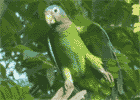 |
| http://disney.wikia.com/wiki/Jiminy_Cricket/Gallery |
Character of the Month:
Love Songs, Perfume, and Chocolate . . . wild romance in Windsor
February 2015
Part I: Combs & Love Songs
Now that we’re seeing the first profusion of dry-season flowers and the sun is setting noticeably later, Windsor wildlife is tuning-up for a little romance. The Jamaican Orioles (aka Aunty Katy; Icterus leucopteryx) are practicing their songs and the Sad Flycatchers (aka Little Tom Fool; Myiarchus barbirostris) are bubbling their happy tune.
But with a symphony of audible and ultrasonic choruses, the true virtuosos are insects! And according to my friend Daniel (he swears he’s not biased . . . ) and Walt Disney, the best songsters belong to the Order Orthoptera (from the Greek ortho = straight + pteron = wing):
| Crickets (Family Gryllidae) | Katydids (Family Tettigoniidae) | Grasshoppers (multiple families; we’ll showcase Acrididae) | |
 |
 |
 |
 |
| Cave-adapted Uvaroviella cavicola | Neoconocephalus sp. Female |
Dellia karstica (top) and Dellia maroona (c) Daniel Perez-Gelabert |
The Windsor Orchestra (insects & frogs) |
Insects generate noise (chirps, clicks, buzzes, etc.) by a number of different mechanisms. Some species clap two body parts, such as slapping together their wings or wing covers (called elytra), just as humans do with castanets. Other insects might drum a percussive rhythm by directly tapping the substrate with a part of their body. And still others will generate sound through the vibration of their wings (think of female mosquitoes), body parts (bees), or a structural mechanism called a tymbal (cicadas).
Then there is the process of stridulation: generating sound or vibrations through the friction of moving two body parts across one another. Think of a comb: I’d recommend one which is fine-tooth on one end and broad-tooth at the other.
If you run your fingernail along the comb’s teeth, you can do so slowly . . . or quickly. You can repeat a “scratch” a few times on the fine-tooth section before ending with a flourish on the broad-tooth. You can increase or decrease the time interval between your “scratch”. You have a myriad syncopation options from which to create a tune which is uniquely your own, that none of your rivals can match on Valentine’s Day!
And if you were a cricket, katydid, or grasshopper, you wouldn’t have had to run . . . oops, sorry . . . hop to the store to buy a comb, you’ve got everything you need on you.
Located along the underside of an orthopteran forewing, there is a “stridulatory organ”, a large vein covered with serrations, much like the teeth of a comb. In crickets and katydids, the “chirping” and “rasping” sounds are created when the animal runs the smooth scraper top of one wing along the teeth at the bottom of the other wing. In crickets, the male also holds his wings up and open, to create an acoustic amphitheatre (kind of like the Sydney Opera House, but on a teeny-tiny scale). In grasshoppers, it is more common for the males to rub the upper part of their hind leg (the femur) against the stridulatory organ of their forewings or abdomen. It’s hard to imagine that there could be so many different tooth-serration arrangements and ways to rub your wings or your legs together to generate a unique sound, but each species does, indeed, have a unique signature tune.
| Sonograms from a few US Orthoptera. To listen to the actual songs, visit the neat website of the University of Florida's Entomology Dept. |
Gryllus assimilis, Jamaican field cricket [Dominant frequency 3.6 kHz].  |
Gryllus pennsylvanicus, Fall field cricket [Dominant frequency 4.7 kHz].  |
Allenomobius allardi, Allard's ground cricket [Dominant frequency 7.7 kHz].  |
Pterophylla camellifolia, Common true katydid [Dominant frequency ca. 4 kHz].  |
With male crickets chirping their hearts (wings?) out – and in most, but not all orthoptera, only the males produce sound – they strive to attract the attention of females while repelling other males with their loudest calls. Kind of, “don’t I sound big, so you don’t want to get in a fight with me” signal to other males. When a female approaches, males of some species will shift to a very quiet courtship song: it's helpful if your predatory neighbours can't hear you when you are . . . you know . . . rather preoccupied. And some males will then chirp out a copulatory song after successful mating.
[Author’s Note: For Valentine’s Day, use your judgement as to whether you should deploy this last “boastful" signaling strategy for the neighbours to hear. We'd also recommend caution in too-quickly imitating the "Snoring Frog" (Osteopilus crucialis) in the recording by The Windsor Orchestra.]
So, it’s dark and the mood music is all around Windsor. Everyone (at least, those fortunate enough to be an insect . . .) is literally feeling the good vibrations through tympanic receptors in their front legs, which transmit changes in pressure to the brain via the trachea . . .
Part II: Leg Hairs & Perfume
 |
| Close-up photo of an Euglossa orchid bee (c) pondapple, flickr.com |
The legs of male orchid bees are uniquely modified to collect and store volatile compounds (i.e. oils which evaporate) from plants. When a male visits a flower, pollen grains or packets of pollen attach to his legs. During a day in Windsor, Euglossa jamaicensis might collect pollen from orchids, but also from flowers of the tank bromeliad Aechmea paniculigera, the Jamaican Rose Blakea trinervia, or several species of Miconia, to name but a few plants they’ve been observed to visit.
With pollen attached, I’m now going to plagarize mercilessly from wikipedia.org:
". . . volatile compounds from the pollen . . . are picked up using special brushes on the forelegs, transferred from there by rubbing the brushes against combs on the middle legs, and
finally these combs are pressed into grooves on the dorsal edge of the hind legs, squeezing the chemicals past the waxy hairs which block the opening of the groove, and into a
sponge-like cavity inside the hind lower leg."
Males can then release these volatile “fragrances” at display sites in the forest understory, where matings occur. He can produce a “pure” fragrance if he visits only a single species of flower or he can create a “blended” fragrance. Whether it’s the plants leading the male bee (e.g., a plant “wants” to make sure a pollinator visits the same species to ensure effective cross-pollination) or the female bees are showing a perfume preference so the male has to make sure he hits the right combination of flowers, we really don’t know. But, as parfumiers go, Euglossine bees are merveilleux.
Part III: The Doubters Amongst You
So, you’ve got your comb, you’ve got your pollen-encrusted hairy, waxy legs. For those of you who worry that this might not result in the most romantic, passionate Valentine’s Day encounter that you have ever experienced in your entire life . . . well, there's always the stand-by chocolate to give your sweetheart. Of course, you first must hope that the flower of the cocoa tree (Theobroma cacoa; from the Greek theos = gods + broma = food) was pollinated by . . . you guessed it . . . an insect (!) in order for a cocoa pod to be produced. But, no worries, the tiny flying midges in Windsor have everything under control.
 |
 |
| (c) Natural History Museum, London UK |
So, for a wild and happy Valentine's Day, we suggest buying your sweetheart (or, heck, buy for yourself) a Cadbury's Creme Egg, made from cocoa solids grown in Jamaica. And for goodness sake, fight to make sure your Creme Egg contains at least 20% cocoa solids, not a measly 10%.
If you'd like to see more photographs highlighting the wonderful diversity of Caribbean insects and meet others who find insects fun and fascinating, we recommend signing-up to the Facebook group Insectos Caribeños, which is administered by Daniel Perez-Gelabert.
I'd also like to thank Daniel for reviewing the orthoptera information, give credit to Tanja Toftemark Ingversen, who braved the Windsor mosquitoes to patiently watch flowers in the forest, and highlight Jacqueline J. Belwood's neat research on bat-katydid interactions in Panama.
Sources of information
Belwood, J.J. 1988. Sounds of silence. Bats Magazine VOL. 6, NO.2 Summer 1988 (published by Bat Conservation International).
Perez-Gelabert, D.E. 2001. Two new species of grasshoppers, Dellia karstica spec. nov. and Dellia maroona spec. nov (Orthoptera: Acrididae) from the Cockpit Country, Jamaica. Journal of Orthoptera Research 10: 75-80.
Toftemark-Ingversen, T. 2006. Plant-pollinator interactions on Jamaica and Dominica: the centrality, asymmetry, and modularity of networks. M. Sc. Thesis, University of Aarhus, Denmark.
| PREVIOUS CHARACTER | NEXT CHARACTER |

